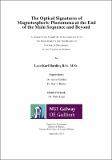| dc.description.abstract | In recent years, very low mass stars and brown dwarfs, together known as ultracool dwarfs, have unexpectedly been detected as a radio transient source, where periodic bursts of radio emission were also discovered. Periodicity has subsequently been detected in H-alpha and other photometric data from a number of these objects. It remained unclear whether this periodic behavior was related to the presence of the periodic pulsed radio emission. This thesis investigates this possible connection, and presents multi-epoch periodic photometric variability from a lengthy campaign encompassing six radio detected ultracool dwarfs, spanning the ~M8 - L3.5 spectral range. These include the M tight binary dwarf LP 349-25AB and L tight binary dwarf 2MASS J0746+2000AB, as well as the M8.5 dwarf LSR J1835+3259, the M9 dwarf TVLM 513-46546, the M9.5 dwarf BRI 0021-0214, and the L3.5 dwarf 2MASS J0036+18. Five of these dwarfs exhibit periodic photometric variability, where three of these are newly discovered. One other shows persistent variability, with the possibility of periodicity detected in the data. This work was primarily carried out using the GUFI photometer (Galway Ultra Fast Imager), an instrument commissioned during this campaign to specifically detect optical signatures from these objects, currently stationed on the 1.83 m Vatican Advanced Technology Telescope, on Mt. Graham, Arizona. We sought to investigate the ubiquity of periodic optical variability in both quiescent and time-variable radio detected ultracool dwarfs. The periodic variability is associated with the rotation of the dwarf in all cases and we consider a number of causal photospheric phenomena, including magnetic cool spots and atmospheric dust. An exciting alternative may associate the periodic variability with chromospheric auroral hot spots directly related to the previously discovered periodic radio emission. One dwarf in this study is part of this larger study, and we present the photometric results possibly associated with this phenomenon.
In addition to the search for optical signatures from these ultracool dwarfs, and based on the newly discovered rotation periods for the binary dwarfs, we investigate the orbital coplanarity of LP 349-25AB and 2MASS J0746+2000AB. We find that in both cases, the inclination angle of the binary spin axes are consistent with being aligned perpendicularly to the system orbital planes to within 10 degrees, as observed for solar-type binary formation. We consider a number of formation mechanisms for such an alignment, including turbulent core fragmentation, disk fragmentation, multiple formation via competitive accretion and dynamical interactions. For 2MASS J0746+2000AB, we have estimated individual component masses and radii based on evolutionary models, which place the binary system at, or just below, the substellar boundary, and at ~1 Jupiter radius. This is the first direct evidence of spin-orbit alignment in the very low mass binary regime.
In supplementary work, we conducted high-speed photometric monitoring of the active M flare stars YZ CMi and AD LEO, in order to investigate the white light flaring emission present in a stellar flare. We present high-speed photometry in B- and V-band, aimed to observe sub-structure in small to large flare events that is inaccessible to spectroscopy (due to slower cadence). For one flaring event in YZ CMi in particular, we report the detection of resolved loop oscillation events in the decay phase of the flare. These data indicate that a periodically repeating structure is being maintained during this phase of the event. Magnetic reconnection has the ability to accelerate non-thermal electrons in to the lower atmospheric regions of these stars - perhaps producing this continuum emission.
Finally, in the later stage of the doctoral work, we built and commissioned a second instrument - the Caltech HIgh-speed Multi-color camERA, or CHIMERA. This photometer has the capability of observing simultaneously in g' and either r' or i', and does so by using the new innovative technology from Andor - the NEO sCMOS detectors. These are capable of obtaining 100 frames per second full frame, or >1600 frames per second sub-frame. The instrument was commissioned at prime focus of the Palomar 200'' telescope, and is stationed as a facility instrument to be used as a Palomar Transient Factory follow-up instrument, as well as being available for a wide range of astronomical observations, such as eclipsing binaries, transiting exoplanets, brown dwarfs, flare stars, and indeed any detected transient source in the sky. | en_US |


